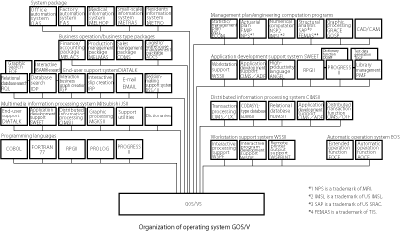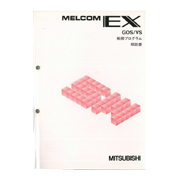GOS/VS was the operating system for the MELCOM EX series general-purpose computers announced by Mitsubishi Electric in 1985. The maximum number of users, maximum number of terminals and maximum number of connectable devices of GOS/VS were approximately 10 times those of UTS/VS for the COSMO series, while new additions included support for dual-processor systems and a function for optimizing use of the computer’s resources. It also enabled the same command procedures in TSS and batch processing and the operation procedures for simplifying system operations.
Major systems that made up GOS/VS included:
- (1) Mitsubishi network architecture MNA
- MNA was the integrated network architecture designed for combining various Mitsubishi Electric computers. Its control programs consisted of a virtual telecommunication access method (VTAM) that operated on the EX machine and a network control program that ran on the communication controller. It supported a leased line, public line, DDX network, ring-type LAN and bus-type LAN. With functions such as RJE (remote job entry) terminal pass-through, distributed file transfer/access, distributed transaction processing and inter-system communication, it was aimed at realization of an “open network.”
- (2) Distributed information processing system CIMS II
- CIMS II was a system aimed at realizing integration of an online function and a database function in response to the demand for online processing that included inventory management and production management, and at further evolution into distributed processing. Available database functions were the relational database RDMS II and CODASYL-type EDMS II. As for online systems, CIMS II enabled communication between online systems on different computers by utilizing the technologies of CIMS and TIMS for the COSMO series and by supporting distributed processing.
- (3) End-user support system DIATALK
- DIATALK was a system that focused on ease of use and user-friendliness, and enabled even non-computer professionals to perform database and file search, create slips and business graphs, exchange e-mail, carry out electronic filing and execute a decision-making function in an interactive manner based on menus written in Japanese.
- (4)Application development system SWEET
- SWEET was an interactive system based on the Japanese language, and consisted of a group of tools for increasing productivity in the development of the program for routine work by enabling the user to manage the program lifecycle in an integrated manner.
- (5) Workstation support system WSS II
- WSS II was a system that enabled the user to operate the computer while interacting with it from a terminal in full-screen display.
- (6) Improved system operability
- Automatic operation system EOS allowed monthly scheduling of automatic power ON/OFF, automatic job scheduling and use of automatic response to commands, thereby achieving labor-free, efficient operation.
- (7)Programming languages
- The operating system allowed the user to use languages such as ANGEL, which increased productivity in COBOL programming, PROGRESS II, which was a simple business-use language used in Mitsubishi Electric’s office computers, and PROLOG, a language for artificial intelligence, in addition to ANSI-compliant COBOL and FORTRAN 77.



